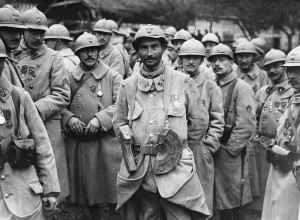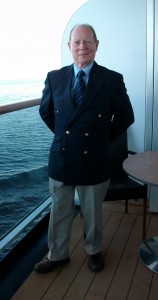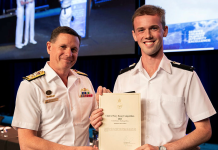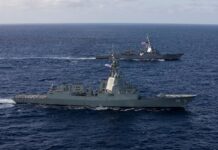
IF AUSTRALIANS in general and the RAN in particular, have a very shaky grasp upon the major events which have shaped this nation’s naval history, then they have even less recall (and perhaps regard) for the exploits and achievements of those naval men and women Australia has chosen to distinguish and recognise with honours and awards.
Up until very recently, and perhaps not even now, how many knew and acknowledged that the first decoration won under the Australian flag in World War I was the DSO awarded to Lieutenant Thomas Bond RANR for his actions at Bita Paka on 11 September 1914? There are records of other awards winners – almost all of them officers, and admirals at that, until very recently – in the names given to naval formations, organisations buildings and ships, but if there is any remembrance within the RAN, or anywhere else, of the exploits of Lieutenant Bond, I’m not aware of it.

The Project
The idea for the Bravo Zulu project came about in conversation with my collaborator and researcher-in-chief for several of my books on Australia’s naval history, David Ruffin. We had noted that, except for the significant record of honours and awards (H&A) in the two world wars created by Chief Petty Officer Atkinson in the 1980s, With Skill and Valour, and that for the most part was just a bare record of the awards, one had to hunt around for any similar information on H&A for later conflicts.
As well, there was no record we could find of H&A for service in what is now termed ‘non-warlike’ circumstances. (Veterans of the committee battles in Defence during the 1980s and 1990 may well bridle at that description of what it was they were engaged in!) So, as regularly as clockwork, twice a year (after 1983) the media would carry as series of those little one-line citations for fortunate folk in the Military Divisions of the Honours lists. ‘Chief Petty Officer M. Bloggs, OAM for services to motor transport’.
Working on the premise that one can tell quite a lot about the development of an organisation and its activities by the H&A it dishes out, we resolved to make an attempt to put flesh on these little bland notices. We would find out and tell the story of Bloggs, starting with his service history and things he had been engaged in, and then why he had got his gong. Women readers can relax: I’ve used the male pronoun because the vast majority of the nearly 3,600 recipient of H&A on whom we have assembled data were men. I don’t endorse this; it’s just the way it is.
We resolved to go back as far as we could and still be able to claim that the recipient was ‘Australian’. That turned out to be a DSO won in 1900 in South Africa, but presented in 1901. We would draw a line on our research sometime in the future as we concluded the writing. We thought that might be 2011 – the centennial of the RAN – but, although we are getting much closer to the end we haven’t reached it yet, and Queens Birthday 2014 might turn out to be the finish line.
The net crucial decision was who we would include in our research. ‘Everybody’ sounded good, but even then we recognised the danger in biting off more than we could chew. ‘All with post-nominal entitlements’ sounded better, but we recognised that scales for awards active during four of the conflicts meant that, in many cases, there was little to choose between the actions which eventually gained a recipient a DSM and those that resulted in a MID. So, we decided to include the MID and its later Australian equivalent.
Foreigners who got gongs while they were serving with the RAN or on RAN service would be included. Foreign awards to Australian naval people would also be included where these had a similar status to Imperial or Australian awards, as would bravery awards, governmental or otherwise. Campaign medals and awards for longevity and service would not, nor would commendations. For those who will take umbrage at their omission under these criteria I can only say that we have left the field open to you to produce the companion volumes to Bravo Zulu covering what we have omitted and wish you an easier time with your research.
Methodology
Herein lies our worst mistake. We assumed that, just as Atkinson and researchers who have come after him have had access to the details of naval H&A, we too would simply need to access the records safely and securely lodged in the National Archives of Australia (as the Archives Act requires) by the Department of the Navy and Department of Defence. As we started our quest at the beginning (a very good place to start as Julie Andrews reminded everybody), we appeared to be on a sound research footing as there is a delightful amount of information on most naval H&A up until World War II.
However, the access enjoyed by Atkinson began to look privileged the deeper we got into that conflict. We realised that there had been a war on, but the writing up of recommendations for awards varied from excellent to awful, with most RAN commanding officers exhibiting a marked disinclination to say clearly why their men deserved gongs. Those who have, in recent times, constructed cases for retrospective awards to various naval people generally take aim at the bureaucracy or even ‘bias’ at senior levels of the Navy. I think there is a simpler explanation: the appalling standards of many recommendations must have left the poor bureaucrats and Admirals scratching their heads.
Records of H&A were a little better for the Korean War, not very good for Indonesian Confrontation (for which only two decorations were made) and Vietnam was pretty much a shambles. After that things got much worse. I know Jeffrey Grey in Up Top had a hack at naval record keeping, a sentiment I shared in my own books on the period, but I had no expectation that there would be, for all intents and purpose, NO records on naval H&A recipients in the Archives from around 1970. So, if you think that ‘They’ have it all recorded, think again. Guard your records of your naval service carefully: reconstruction is most likely impossible.
We had recognised that the Navy got excited about digitisation and in 1970 whisked all the information on those very useful, though sometimes illegible, Service Record cards off to be noughts and ones. This mean that we could no longer trace a recipient’s career past April 1970. Ironically, the guy in charge of this project got an OBE for his pains. We also knew that the Archives Act would close out access to official records in any case 27 years before the end date. We thought we could live with struggling to find information on 27 years worth of H&A recipients, most of whom we expected to still be alive. We did not realise we were facing a virtual official record blackout of more than 40 years.
What to do? Well, when the going gets tough… as another song goes. Another apposite aphorism is ‘Persistence pays’. Persistence, cunning, knowledge gained in over ten years of research, knowing who to ask and the kindness of complete strangers, plus a few dollars invested in the British Archives in Kew and the US National Archives in Maryland have enabled us to edge closer to the goal.
I won’t go into all the stratagems we have tried here, but there are no squares outside which we have not thought. Our major resource has, however, been the recipients themselves or their families. I take this, the first but not last, opportunity to express publicly my deep appreciation for the cooperation I and my team have received from the many hundreds of people we have contacted. This is their book and they have more than played their part in getting it written. My oldest respondent described to me the circumstances in which he won a DSM in sinking a Japanese submarine in 1944, which I was delighted to add to the narrative.
Which brings up my final comment in this section. In January 2012 David and I analysed the situation. In broad terms, after three year’s work we still need to discover the details and circumstances of around 2,000 awards. Extrapolating our rate of progress, especially as we had already picked the low-hanging fruit, showed that we would not finish the task before the grim reaper came for us. We resolved to seek help with the research. The team of volunteers we assembled, collectively known as the Beavers, has made all the difference. The composition of the group has changed and we have been helped by many others on an opportunity basis, but the project would have sunk, probably without trace, except for the enthusiasm and diligence of the Beavers.
Outcomes and Progress
What is going to emerge from all this effort? That’s always been pretty clear. My habit is to start a book project by writing the Introduction, which sets out what the reader is going to find in the finished product, and then setting out the Table of Contents, which outlines the steps by which the tale will be told. The Introduction has changed very little over the six years although the Table of Contents has got longer. Whatever title is settled on for the manuscript, Bravo Zulu will result in a history of the development of Australia’s navy as told through the contributions of its H&A recipients. There are 16 chapters, three of them describing the H&A system as it applied throughout the past 114 years and the other 13 telling the stories of recipients, set in a framework of what was happening around them.
In A4 sheets, and with the five finals chapters covering the period 1975-2014 still with holes in them to be filled, the manuscript extends to over 800 pages.
At time of writing there are just under 500 stories to be completely researched. The first 11 chapters have been reviewed by a civilian ‘Control Group’ and are in good shape, the remaining five have been drafted, and I am working to update the final chapter. Our research is concentrated on filling the gaps in the period 1975-2001, after which things get somewhat easier.
We have given very serious attention to reducing or eliminating all navalisms, acronyms and the other things that distract lay readers in the average book of naval history. We have assumed no knowledge of navies or of the RAN. There are introductory and explanatory notes and extensive use of footnotes, thanks largely to the work of the Control Group. Access to individual entries on recipients will be via the Index at the back of the book which contains (abbreviated as appropriate out of concerns for space) surname and initials, rank at the time of the award, number, service, award, date of award and the page reference.
When the work will be finished is a question I cannot answer. ‘Soon’ is my profound hope. But then comes the hard part – finding a publisher. I’m already examining options on how to get what will be a very substantial pile of paper into the hands of the public at an affordable cost, including crowd funding. I would hope to achieve this in 2015.
What Can the Reader Expect?
It might not come as much of a surprise, but the reader will discover, as we did, that official records can be in error like any other account. One group of men received awards for their performance in a battle they did not fight. Other were credited with service they did not perform (as an anguished pencil marginal note against one recipient’s name exclaimed). Citations concealed more than they revealed, often for security reasons but also because of confusion in the minds of those who wrote them.
They will marvel at the kinds of situations in which RAN people found themselves and, I believe, be impressed by the service they rendered to Australia or to our allies. It may be observed that our US allies frequently use language verging on hyperbole (although, from a researcher’s point of view they write damn fine citations which tell the recipient what he or she is getting the gong for, not like the Imperial and Australian habit of obfuscating something so gross). That won’t disguise their appreciation for the duty rendered by Australians who seem, in this as in other national endeavours, to punch above their weight.
It is my hope that readers will also come to realise that navies, including our own, are more than collections of expensive grey-painted machinery, and that it is people who make them what they are. I also hope that the readers will appreciate just what it takes to create and keep in existence a navy by reading of the contributions made in so many different ways to making the RAN a little better by enthusiastic and dedicated people doing a bit more than they are paid to do, and sometimes a lot more than that.
The nature of the narrative also changes as the chapters advance. Necessarily, the background stories are largely descriptive in the earlier chapters. As we gained access to living recipients there was more to tell and the entries (and chapters) became longer, but I think more interesting. I have tried to keep the word count under control: in doing so there are some excellent tales which do not get a decent airing. My resolve is to tell these outside the confines of the current manuscript.
There ware two things the reader will not find. Except for one or two mild remarks about the nature of an award in the circumstances, Bravo Zulu is about H&A that were received, and not about those that might or should have been received. Those eager to rewrite history will not find any basis for their arguments in the book.
We regret that readers will also not find the reasons behind each and every award, which had been our goal. Faced with incontrovertible proof that, for example, all the recommendations for awards to members serving with the British Pacific Fleet were destroyed in London after the war, we can do little but infer why they were probably made. Others have simply defied our ability to get to the story.
A Final Word
If any of the readers of this article are H&A recipients who want to know if they are in the book, the answer is ‘Yes’. If your award fits the criteria above, you’re in. The quality and completeness of the entry that describes the background to your award will depend on the information we have been able to glean. I’m always happy to discuss this with a view to improving the end product.

Ian may be contacted on pfennigs1@bigpond.com



